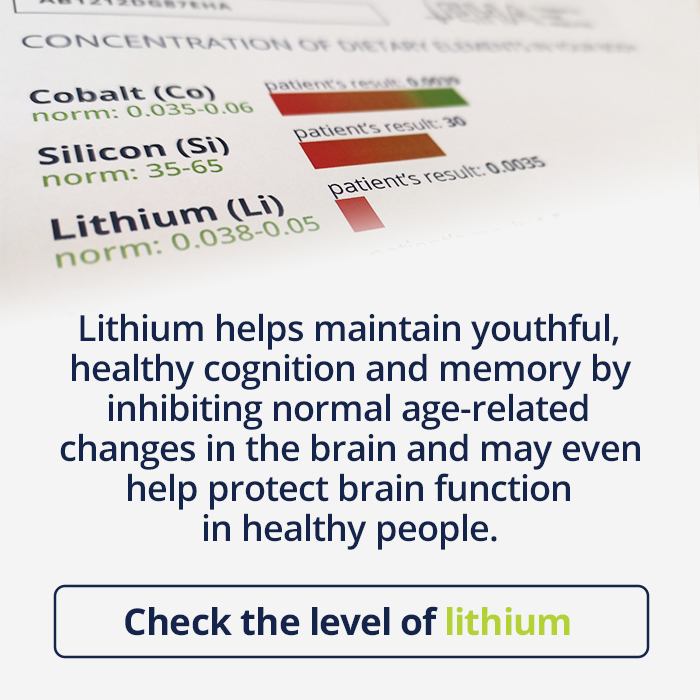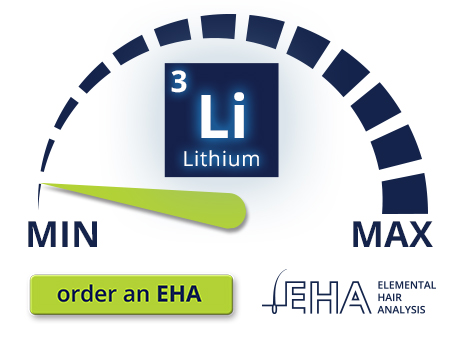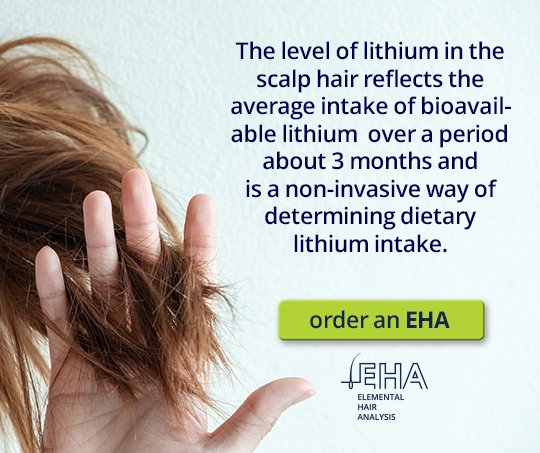 Lithium compounds have been the most popular mood stabilizers for years. Lithium was first used pharmacologically in the 19th century and is known to have a preventive effect on recurrent depression. After the discovery of the anti-manic effects of lithium, it has been used for over sixty years in the treatment of bipolar disorder in both the acute and the maintenance phase of depression and mania. The updated guidelines recommend lithium as the drug of choice for acute manic, mixed, and depressive episodes in bipolar disorder.
Lithium compounds have been the most popular mood stabilizers for years. Lithium was first used pharmacologically in the 19th century and is known to have a preventive effect on recurrent depression. After the discovery of the anti-manic effects of lithium, it has been used for over sixty years in the treatment of bipolar disorder in both the acute and the maintenance phase of depression and mania. The updated guidelines recommend lithium as the drug of choice for acute manic, mixed, and depressive episodes in bipolar disorder.
Lithium prescription rates have decreased at some point due to growing doubts about its effectiveness based on evidence (evidence-based medicine). Earlier research on lithium did not meet newer research standards, also because of concerns about life-threatening toxicity and difficulty to use. This was also due to changes in the diagnostic criteria for bipolar disorder over the years and the emergence of newer drugs, such as valproate and atypical antipsychotics, which could also reduce the use of lithium. Lithium is currently considered the drug of choice in the long-term prophylaxis of new ChaD episodes, considered the only substance to prevent both new depressive and manic episodes. Moreover, lithium is the only drug with an established anti-suicidal efficacy in bipolar disorder.
Despite such strong documented healing effects of lithium, the specific mode of action of it in regulating mood has still not been fully elucidated. Along with the direct inhibition of glycogen synthase 3β kinase (GSK3β), the effects of lithium on neurotrophic factors, neurotransmitters, oxidative metabolism, apoptosis, neuronal and glial structures, secondary messenger systems, and biological systems such as the circadian rhythm and the hypothalamic-pituitary (HPA) axis have been reported. It has been suggested that all elements of the HPA axis underlie the therapeutic effects of lithium. Although the pathophysiology of bipolar disorder has not been fully elucidated, extensive literature indicates that bipolar disorder is associated with significant neuroanatomical changes, including damage to the integrity of the frontal-subcortical and prefrontal-limbic regions. Further evidence suggests that changes at the cellular level, including dysregulation of glial-neuron interactions, underlie such neuroanatomical changes. This suggests that lithium may exert its healing effects through mechanisms related to neuronal plasticity. (Francisco López-Muñoz et al. 2018).
MECHANISM OF ACTION OF LITHIUM
What we know about the mechanism of action of lithium is its inhibitory effect on glycogen synthase 3β kinase (GSK3β). Glycogen synthesis is mainly activated during periods of rest in the liver, induced by insulin in response to high blood glucose levels (e.g., after eating a high carbohydrate meal). Hormones such as adrenaline, noradrenaline, and insulin influence glycogenesis. However, the key enzyme responsible for glycogen synthesis is glycogen synthase.
Glycogen synthase has two forms that differ in their activity. Glycogen synthase is the active enzyme is dephosphorylated. On the other hand, its phosphorylation transforms it into an inactive form of glycogen synthase. 6 different protein kinases participate in the regulation of this process. One of them is glycogen synthase kinase 3β (GSK3β) inhibited by lithium compounds. Lithium, by inhibiting GSK3β, in turn influences the expression of the Fxr1 protein (fragile X autosomal homolog 1). Fxr1 expression in the brain is increased in response to lithium. It has been shown to regulate de novo synthesis of the GluA2 subunit of the AMPA receptor (glutamate receptor) during long-term synaptic enhancement of hippocampal neurons (Cook et al., 2014). This process may affect sleep regulation and synaptic homeostasis (Jivan Khlghatyan et al., 2020). Further research on the Gsk3β-Fxr1 signaling module should clarify whether it also forms the molecular link between mental illness, sleep homeostasis, and autonomic homeostatic plasticity of the cell (Kavalali and Monteggia, 2020). Lithium plays a role in these processes.
LITHIUM AND LONGEVITY
Lithium helps maintain youthful, healthy cognition and memory by inhibiting normal age-related changes in the brain and may even help protect brain function in healthy people.
Lithium can be a great addition to your longevity plan. The reason probably has to do with telomeres, an increasingly emerging indicator of cellular longevity and vitality. Telomeres cover the outer ends of our chromosomes and protect our DNA from degradation.
Each time the cell replicates, these ends get shorter, and eventually the telomeres get too short to do their job. The theory is that the longer you can maintain long, healthy telomeres, the better your chances of having a solid life expectancy will be. After reaching a critical telomere length, the cell loses its ability to divide. This ultimately means that as we age, we are less able to replace old or damaged cells, which can increase the risk of age-related diseases.
Studies have shown that some people who take long-term high doses of lithium have longer-than-expected telomeres. One study found that in some regions of the US, low levels of lithium found in tap water were moderately associated with increased mortality and life expectancy in humans. There is evidence that lithium can inhibit cellular aging – a natural part of the aging process in which cells no longer function optimally – as an aid to promoting healthy circadian rhythms (Fiona Coutts et al. 2019).
Lithium can induce anti-aging effects by moderating the expression of genes responsible for the proper regulation of telomere length.
Anti-aging strategies that focus on the environment, including normal mineralization, may be particularly useful in preventing excessive telomere shortening among groups at high risk of age-related disorders, such as patients with mental disorders or those at risk of cardiovascular disease, and perhaps even more broadly in the general population.
On a population scale, perhaps one of the broadest and most effective ways of introducing anti-aging benefits over a lifetime would be to change your diet, and recent research suggests that even the water we drink may be important.
Reports indicate that higher levels of lithium naturally present in drinking water are associated with fewer deaths from any cause, fewer people committing suicide, increased life expectancy, and reduced risk of neurodegenerative diseases.
This accumulation of discoveries has sparked interest in the potential to reposition lithium as an anti-aging drug, and even the utility of lithium supplementation in drinking water (like the use of fluoride on the teeth) as a means of keeping people healthy for longer.
However, for lithium, it is currently unknown whether its telomere-elongation effects work similarly in all (i.e., universally), or whether changes in genes regulating the maintenance of basal telomere length also contribute to changes in its anti-aging benefits (Coutts F et al. 2019)
LITHIUM AS A BODYGUARD FOR YOUR BRAIN
A healthy brain naturally produces a variety of proteins that affect cognition and memory and must be removed once they have fulfilled their role. The brain has natural, built-in processes for removing them (ubiquitination). But this cleansing process fades away over time as part of the normal aging process. When that happens, these proteins can start to build up and interfere with your brain.
Preclinical studies indicate that lithium promotes the breakdown of accumulated brain proteins and supports the normal process of removing cellular debris from brain cells in the brain.
Lithium also helps protect neurons in the brain (this is called the neuroprotective effect) by protecting the brain from damage and stimulates the growth of new neurons.
It does this by inhibiting an enzyme called glycogen synthase kinase 3. This enzyme is involved in many metabolic processes ensuring proper cellular function – one of them is the way the brain metabolizes glucose. Thus, lithium can help maintain normal glucose metabolism in the brain.
Lithium has been found to be beneficial in the treatment of strokes, Alzheimer’s, Huntington and Parkinson’s, amyotrophic lateral sclerosis (ALS), and spinal cord injury in animal models of brain injury. In animal models of multiple sclerosis, lithium reduces inflammatory demyelination, and in models of neurodegenerative diseases, lithium also slows neuronal death. Clinical trials are currently underway to evaluate the effects of lithium in these diseases.
Lithium enhances the effects of magnesium and non-steroidal anti-inflammatory drugs, extends life, has a positive effect on civilization diseases, has a beneficial effect on the cardiovascular system and prevents coronary artery disease. It has anti-inflammatory and anti-itching properties. It also plays a role in the bone marrow, preventing heart disease, as well as diabetes and high blood pressure. It co-creates substances that regulate blood clotting and transports vitamin B12 and folic acid to the brain.
DOES LITHIUM HELP CALM YOUR NERVES?
Lithium is a mood stabilizer that is primarily used to treat or control manic episodes in bipolar disorder. But the “manic” symptoms characteristic of bipolar disorder, though much less severe, include hyperactivity, haste in speech, poor assessment of a situation, reduced need for sleep, aggression and anger also apply to the so-called “Mentally healthy people”.
COULD LITHIUM BE OF IMPORTANCE IN PERSONALITY CHANGES?
Lithium in very small amounts appears to be an essential element for good mental health. Where there is a lot of lithium in drinking water, people are warmer, more cheerful, there are fewer rowdies and brutes. In the right doses, it is extremely relaxing. Areas of the country where lithium is present in high amounts in drinking water are characterized by less violence and crime. A US study of 27 Texas counties found that the rates of suicide, homicide, and rape were significantly higher in counties with little or no lithium in their drinking water, compared to counties with higher levels of lithium in the water. Lithium concentrations in the hair were unusually low in 20% of Americans and in samples collected in Munich, Germany, and Vienna, Austria. Links with cases of robbery, burglary and theft were also significant, as well as links with arrests for the possession of opium, cocaine, and their derivatives. Moreover, very low lithium values were often found in the hair samples of patients with schizophrenia.
The level of lithium in the hair is low in certain pathological conditions, such as heart disease, people with learning difficulties and in so-called violent criminals sometimes up to four times.
DOES LITHIUM DEFICIENCY MATTER IN AUTISM?
According to new research in animal models, lithium stabilizes the mood and alleviates repetitive behaviors seen in autistic mice lacking the SHANK3 autism gene (Vedakumar Tatavarty 2020). More importantly, chronic administration of lithium reduced autistic behavior induced by neonatal isolation and restored hippocampal neurogenesis in adult rats, as well as the balance between excitatory and inhibitory activities to physiological levels. These findings indicate that lithium may be a potential therapeutic agent for autism spectrum disorder (ASD) in early development.
Potential mechanisms underlying some of the beneficial effects of lithium are not fully understood, but may include reduction of apoptotic neuronal loss, stimulation of neuronal precursor cell (NPC) proliferation and cell differentiation into mature neurons, and increased levels of neurotrophic factors (Chen et al. 2000; Son et al., 2003; Senatorov et al., 2004; Contestabile et al., 2013). Lithium can alleviate autism-like behavioral abnormalities by regaining the balance between excitation and inhibition. The exact molecular mechanism remains to be determined but may be in part due to the inhibitory effect of lithium on glycogen synthase 3β kinase (GSK-3β) Mintz M. et al. 2019.
According to a study by James Adams, president of the Autism Nutrition Research Center, lithium values were significantly lower when evaluating hair samples in children with autism. Interestingly, low levels of lithium have been found in mothers of autistic children. Similar observations were made in many children with autism who were tested at the Great Plains Laboratory GPL (a laboratory specializing in the diagnosis of children with neurodevelopmental disorders). Some autistic children have lithium values in the lowest one percentile.
According to a study by James Adams, president of the Autism Nutrition Research Center, lithium values were significantly lower when evaluating hair samples in children with autism. Interestingly, low levels of lithium have been found in mothers of autistic children. Similar observations were made in many children with autism who were tested at the Great Plains Laboratory GPL (a laboratory specializing in the diagnosis of children with neurodevelopmental disorders). Some autistic children have lithium values in the lowest one percentile.
According to William Shaw of the GPL, the use of highly purified water (reverse osmosis filters) to prevent the ingestion of toxic chemicals could deprive pregnant women of the trace amounts of lithium in tap water needed for normal brain development, and this deficiency appears to be a significant risk factor for autism. It is possible that this may in fact be just as important as mercury exposure as a risk factor for autism.
Many studies show that the level of lithium in hair is a good indicator of lithium deficiency. The level of lithium in the scalp hair reflects the average intake of bioavailable lithium over a period ranging from weeks to months and is a non-invasive way of determining dietary lithium intake. In addition, lithium is needed for the transport of folic acid and vitamin B12 to the brain. Common lithium deficiencies may be one of the reasons why children with autism require large doses and appropriate forms of these vitamins.
The typical profile of elemental analysis of the hair of a child with autism shows very low lithium intake in children within the spectrum. Blood tests performed in conventional medical laboratories measure lithium but are only useful for measuring very high levels of lithium associated with lithium drug therapy. Such tests are useless for measuring very low levels of lithium associated with nutrient lithium. Lithium is quickly excreted from the body. An assessment of lithium status would require multiple serum, blood, or urine lithium measurements. To obtain information on the long-term average Lithium intake from a single measurement, Elemental Hair (EHA) or Toenail Analysis seems more appropriate. Remember that a low level of lithium in EHA should be correlated with the level of cobalt, chromium, magnesium, and calcium.
DOES LITHIUM HELP REGULATE SLEEP?
Lithium orotate is a natural, side-effect-free alternative that is very useful in regulating circadian rhythms, the sleep-wake cycle. The recommended dose can be as high as 15-150 mg per day for severe depression.
Studies show that lithium can exert a therapeutic effect by influencing melatonin levels at several sites along the retinal-hypothalamic-pineal pathway, thereby modulating the potential value of this physiological stimulus index for circadian rhythm synchronization.
Taking lithium together with melatonin may increase side effects such as dizziness, somnolence, confusion, and difficulty concentrating. Some people, especially the elderly, may also experience impaired cognition, judgment, and coordination.
What are the symptoms of deficiency and how to supplement lithium, we will answer this and other questions in the next parts of the article, which will soon appear on our website.
Author: Dr. Anna Romaniuk, microbiologist, immunologist, psycho-dietician
bibliography:
1. Fiona Coutts et all. The polygenic nature of telomere length and the anti-ageing properties of lithium. Neuropsychopharmacology. 2019 Mar; 44(4): 757–765
2. Xiaoyan Wu et all. Lithium ameliorates autistic-like behaviors induced by neonatal isolation in rats. Front Behav Neurosci. 2014; 8: 234
3. Tatavarty V et all. Autism-Associated Shank3 Is Essential for Homeostatic Compensation in Rodent V1. Neuron. 2020.
4. Mark Mintz and Emma Hollenberg. Revisiting Lithium: Utility for Behavioral Stabilization in Adolescents and Adults with Autism Spectrum Disorder. Psychopharmacol Bull. 2019 Jun 20; 49(2): 28–40
5. Francisco López-Muñoz i wsp. A History of the Pharmacological Treatment of Bipolar Disorder Int J Mol Sci. 2018 Jul; 19(7): 2143

















